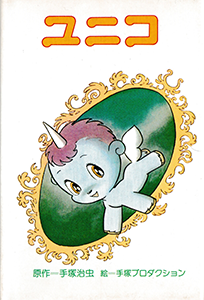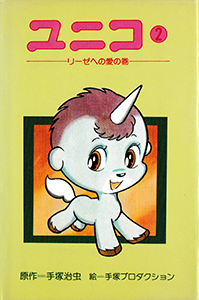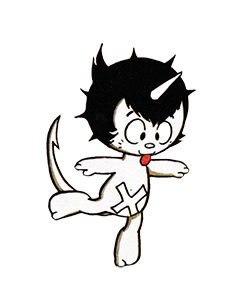Publisher: Sanrio
Published: November 5, 1977, April 4, 1978, and October 15, 1978
Demographic: Shoujo
Starting December 1967, Sanrio began publishing their gift book series. They made these small books to give as gifts for multiple occasions, including birthdays, marriages, wedding anniversaries, illness/get well, friendships, and showing gratitude. During Unico’s run in Lyrica, three gift books were put out with short stories not found in the published manga. The books were written in picture book style with the illustrations on one page and text on the other. Themes were like the regular manga as well.

Book 1:
Title: ユニコ
Translation: Yuniko / Unico
Published: November 5, 1977
Synopsis:
The West Wind drops Unico off in a forest where he meets the black and white cat, Chao (also known as Katy to Westerners). The two find a young girl named Sweet sitting next to a tree stump. They become friends, and when Sweet hears voices, they all go to investigate. A living tree was telling stories to the nearby flowers, and Sweet was curious about the music box mentioned. They continued through the forest and spot a creepy mansion. Sweet is afraid to go, as she believes there may be vampires. Chao and Unico assure it’s fine and Sweet follows them.
They enter the home, but cannot find the music box. Instead, they find a talking lantern that explains the music box is no longer there. The furniture around in house have faces and tell the three that the witch named Saibane (possibly Cyberne) has stolen the music box. Sweet really wants to listen to the music box, so she wants to find the witch. The forest grows darker, and a creature lurks in the shadows. A black leopard appears, but Unico attacks it. The creature turns into some form of black shadow or cloud and disappears.
The three leave the forest and are exhausted. Sweet spots a nearby town and they head toward it. When they arrive, they smell food and the townspeople are eating together. The people notice Sweet, Chao, and Unico and let them join in. Soon everyone is singing and dancing. Just outside of town, they could hear crying. It was the lake. She was crying because the witch stole all the fish. This made all the townspeople burst into tears as well. The three spot the witch in the sky flying on her broomstick, and Unico takes action.
He fights the witch and knocks her out of the sky. She plummets to the ground, and where she landed is the music box. Sweet picks it up and when she opens it, beautiful music began to play and stories she didn’t know started one after another. This made Sweet thrilled. When it was time to leave, Chao and Unico left, but Sweet could not say goodbye.

Book 2:
Title: リイゼへの愛の巻
Translation: Riize e no Ai no Maki / Love for Liese Volume
Published: April 10, 1978
Synopsis:
A young man and woman named Hans and Liese living in a small village near the Alps. Hans is a goatherder in the village and he and Liese are in love. One day, Liese tells Hans she’s tired of the small village and wishes to leave. They venture out toward a forbidden forest, but Liese reminds Hans that people do not return once they enter. Hans tells her it’s just a fairy tale and they enter the forest. They discover a beautiful area, which is the sacred paradise of Olympus. Hans is quickly punished and taken away by the gods. As Liese weeps, Unico appears and tells her he’s alone. Since Liese is alone as well, she tells Unico to come with her.
Unico learns about what happened when Liese retells the story to Hans’s faithful companion, Bernard the St. Bernard. After Liese gifts Unico a red scarf, he wants to take Liese to see Hans. Unico transforms into his adult self and flies Liese and Bernard to where Hans is. Liese pleads with the gods to let Hans go, but they refuse and instead call upon the West Wind to take Unico away. The gods tell Liese the only way to free Hans is to sacrifice herself, but Unico won’t let her do it alone. Bernard, Liese, and Unico surround Hans as a fierce blizzard surrounds them. Soon, the blizzard stops and the snow is gone. Hans is free, and everyone survived. The West Wind takes Unico away as Liese calls for him.

Book 3:
Title: ほんとうは悪魔なんだけどの巻
Translation: Hontou wa Akuma Nandakedo no Maki / I’m a Devil, Actually Volume
Published: October 15, 1978
Synopsis:
After being dropped off in a secluded location, the young devil, Sataa, finds Unico. Sataa welcomes Unico into his home as he believes Unico is also a devil, and feeds him well until Unico corrects the mistake by saying he’s actually a unicorn. Sataa kicks Unico out, but Unico stays nearby because he wants to be friends.
The next day, Sataa is watching a young girl named Aruru from a tree. He has hearts in his eyes and Unico confronts Sataa, asking if she’s his girlfriend. Sataa is not amused and attacks Unico, then used his magic to terrorize the small town. Unico confronts Sataa again, this time about the terrible things he has done, but Sataa is apathetic.
That night, Sataa believes Aruru has appeared before him, but it was Unico’s magic creating an illusion. This upsets Sataa and he kicks Unico out once more, saying that he hates humans.
While waiting in the tree, Sataa notices Aruru has not come out at all. He investigates and finds she has become severely ill. When Unico tells Sataa that Aruru is dying, Sataa is hurt and runs off to destroy the town. Sataa attempts to use his powers, but nothing happens. He is hurt and frustrated, but when there is a sad cry coming from Aruru’s home, Sataa reacts. He forgets he is a demon and uses all his powers to save her. Aruru is cured, and everyone believes it was a miracle.
Unfortunately, Sataa cannot return to the devil world after helping Aruru and begs to not become human. A beam of light comes down and we find on the next page that Sataa is now human. He can to talk to Aruru and in the end, Sataa is happily sitting with her as the sun sets. He lets Aruru know that he’s actually a demon, and she laughs as if he’s joking.

* Translation notes:
Sataa is written in katakana as Sataa/サター, which may be short for Satan (Sataan/サターン) or even translate to Satyr or Sutter. We left it as the katakana spelling as we’re unsure.
Aruru is written in katakana like Aruru/アルル. We can read Aruru as Alulu/Arle/Arles/etc. depending on how you want to translate it.
Note:
These are translations we have tried to provide and may not be 100% accurate.
<< Back
